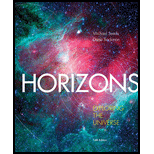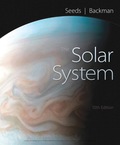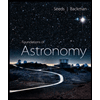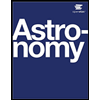
Horizons: Exploring the Universe (MindTap Course List)
14th Edition
ISBN: 9781305960961
Author: Michael A. Seeds, Dana Backman
Publisher: Cengage Learning
expand_more
expand_more
format_list_bulleted
Concept explainers
Textbook Question
Chapter 1, Problem 8P
How long does it take light to cross the diameter of our Milky Way Galaxy?
Expert Solution & Answer
Trending nowThis is a popular solution!

Students have asked these similar questions
The nearest star to our sun is Proxima Centauri, at a distance of 4.3 light-years from the Sun. A light-year is the distance that light travels in one year (365 days). How far away, in kilometers, is Proxima Centauri from the Sun?Express your answer using two significant figures.
When we look at a particular star, we are seeing it as it was 371 years ago. How far away from us (in meters) is the star? Take a year to be 365.25 days.
If a person is standing at the top of an observation tower that is 1200 feet above sea level, how far is it possible to see with a telescope on a clear day? Use 1,970 miles for the radius of the earth. (There are 5,280 feet in 1 mile.) Round your answer to the nearest mile.
(A) 24 miles
(B) 30 miles
(C) 44 miles
(D) 45 miles
(E) 46 miles
Chapter 1 Solutions
Horizons: Exploring the Universe (MindTap Course List)
Ch. 1 - What is the largest dimension of which you have...Ch. 1 - What is the difference between our Solar System,...Ch. 1 - Why are light-years more convenient than miles,...Ch. 1 - Why is it difficult to detect planets orbiting...Ch. 1 - Prob. 5RQCh. 1 - What is the difference between the Milky Way and...Ch. 1 - What are the largest known structures in the...Ch. 1 - Prob. 8RQCh. 1 - How Do We Know? How does the scientific method...Ch. 1 - You and three of your friends have won an...
Ch. 1 - Think back to the last time you got a new phone...Ch. 1 - The diameter of Earth across the equator is 7928...Ch. 1 - The diameter of the Moon across its equator is...Ch. 1 - One astronomical unit is about 1.50108 km. Explain...Ch. 1 - Venus orbits 0.72 AU from the Sun. What is that...Ch. 1 - Light from the Sun takes 8 minutes to reach Earth....Ch. 1 - The Sun is almost 400 times farther from Earth...Ch. 1 - If the speed of light is 3.00105 km/s. how many...Ch. 1 - How long does it take light to cross the diameter...Ch. 1 - The nearest large galaxy to our n is about 2.5...Ch. 1 - How many galaxies like our own would it take Laid...Ch. 1 - In Figure 1-4, the division between daylight and...Ch. 1 - Prob. 2LTLCh. 1 - Prob. 3LTLCh. 1 - Prob. 4LTL
Knowledge Booster
Learn more about
Need a deep-dive on the concept behind this application? Look no further. Learn more about this topic, physics and related others by exploring similar questions and additional content below.Similar questions
- Why are light-years more convenient than miles, kilometers, or AU for measuring the distances to stars and galaxies?arrow_forwardMost distances in the Galaxy are measured in light-years instead of meters. Why do you think this is the case?arrow_forwardThe dwarf galaxy in Sagittarius is the one closest to the Milky Way, yet it was discovered only in 1994. Can you think of a reason it was not discovered earlier? (Hint: Think about what else is in its constellation.)arrow_forward
- Roughly how many solar systems would it take to tile the disk of the Milky Way?arrow_forwardWhat is milky way ? Write just 1 paragraph.arrow_forwardThe brightest star in the northern hemisphere is Sirius. Its distance from earth is estimated to be 8.7 light years. A light year is the distance light travels in one year. Light travels at a speed of 3.00 x 108 m/s. Calculate the distance from earth to Sirius in miles. (1 mi = 5280 ft)arrow_forward
- A parsec is an astronomical unit of distance where 1 parsec = 3.26 light years (1 light year equals the distance traveled by light in one year). If the speed of light is 186,000 mi/s, calculate the distance in meters of an object that travels 7.5 parsecs. marrow_forwardIn astronomy, distances are often expressed in light-years. One light-year is the distance traveled by light in one year. The distance to Alpha Centauri, the closest star other than our own sun that can be seen by the naked eye, is 4.3 light-years. Express this distance in meters.arrow_forward
arrow_back_ios
arrow_forward_ios
Recommended textbooks for you
 Stars and Galaxies (MindTap Course List)PhysicsISBN:9781337399944Author:Michael A. SeedsPublisher:Cengage Learning
Stars and Galaxies (MindTap Course List)PhysicsISBN:9781337399944Author:Michael A. SeedsPublisher:Cengage Learning
 Foundations of Astronomy (MindTap Course List)PhysicsISBN:9781337399920Author:Michael A. Seeds, Dana BackmanPublisher:Cengage Learning
Foundations of Astronomy (MindTap Course List)PhysicsISBN:9781337399920Author:Michael A. Seeds, Dana BackmanPublisher:Cengage Learning AstronomyPhysicsISBN:9781938168284Author:Andrew Fraknoi; David Morrison; Sidney C. WolffPublisher:OpenStax
AstronomyPhysicsISBN:9781938168284Author:Andrew Fraknoi; David Morrison; Sidney C. WolffPublisher:OpenStax Stars and GalaxiesPhysicsISBN:9781305120785Author:Michael A. Seeds, Dana BackmanPublisher:Cengage Learning
Stars and GalaxiesPhysicsISBN:9781305120785Author:Michael A. Seeds, Dana BackmanPublisher:Cengage Learning

Stars and Galaxies (MindTap Course List)
Physics
ISBN:9781337399944
Author:Michael A. Seeds
Publisher:Cengage Learning


Foundations of Astronomy (MindTap Course List)
Physics
ISBN:9781337399920
Author:Michael A. Seeds, Dana Backman
Publisher:Cengage Learning

Astronomy
Physics
ISBN:9781938168284
Author:Andrew Fraknoi; David Morrison; Sidney C. Wolff
Publisher:OpenStax

Stars and Galaxies
Physics
ISBN:9781305120785
Author:Michael A. Seeds, Dana Backman
Publisher:Cengage Learning
General Relativity: The Curvature of Spacetime; Author: Professor Dave Explains;https://www.youtube.com/watch?v=R7V3koyL7Mc;License: Standard YouTube License, CC-BY